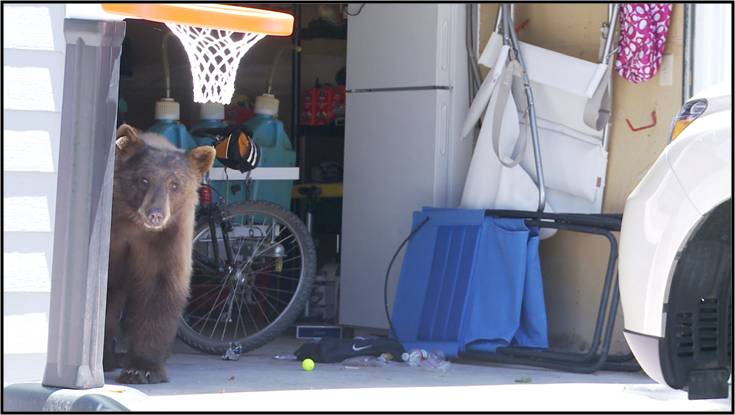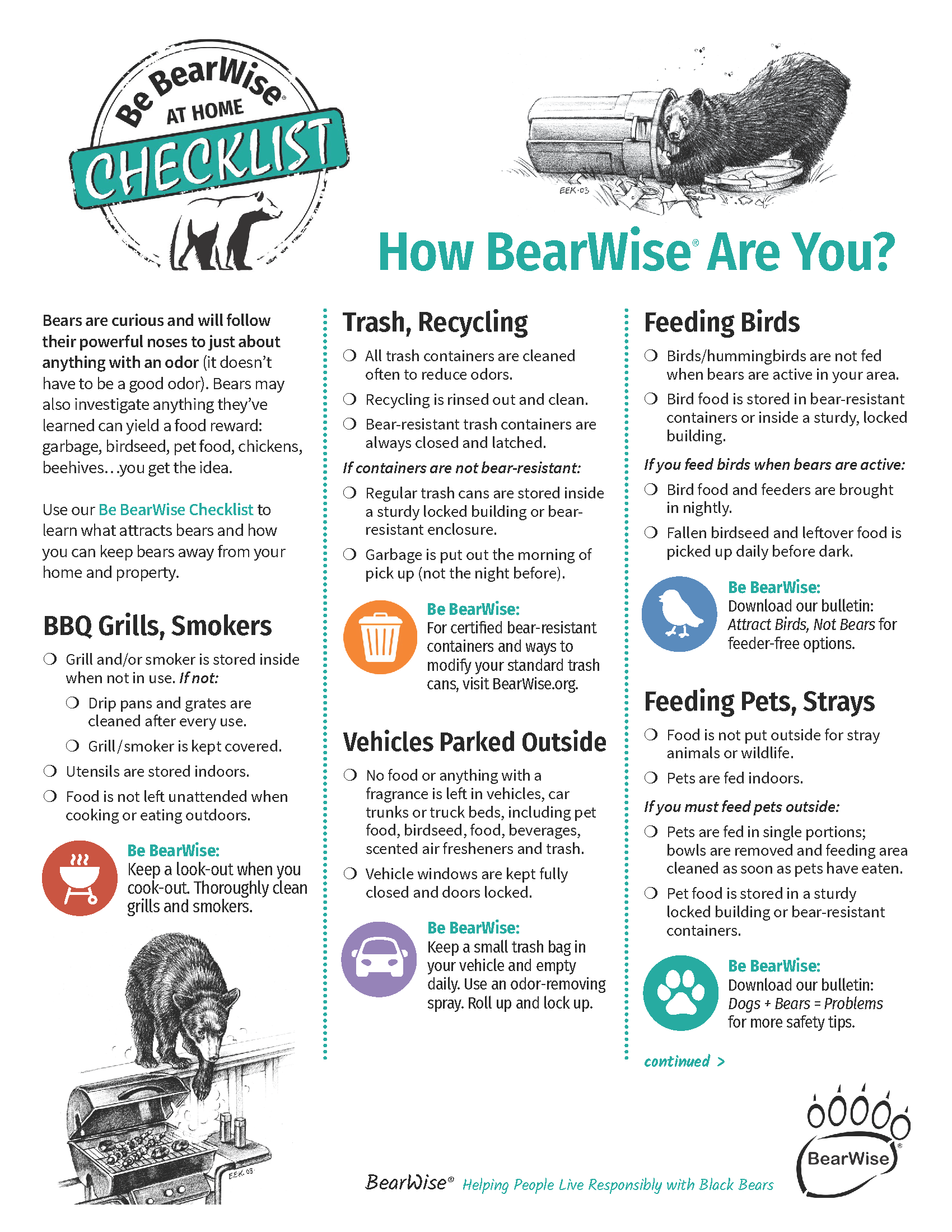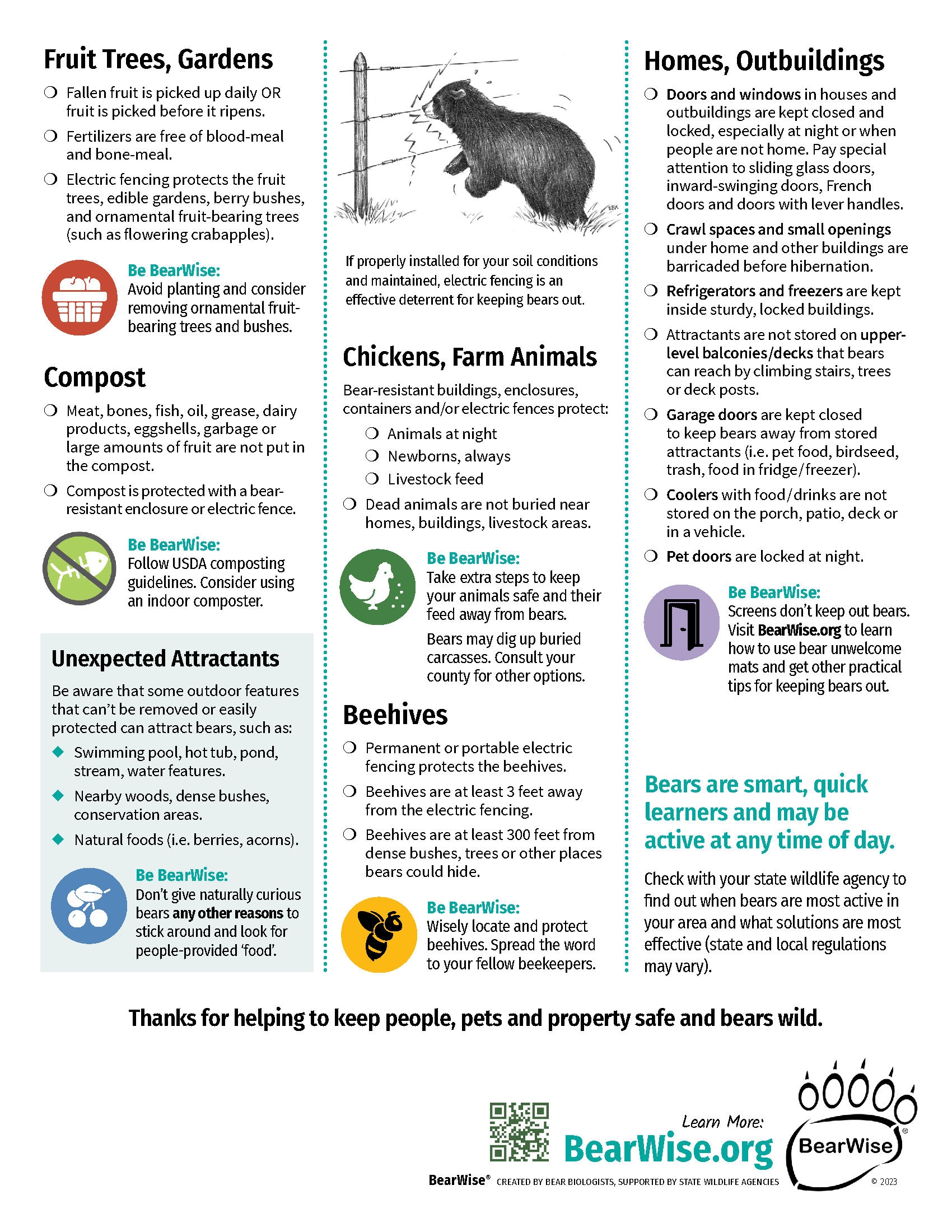Bear in Garage

Black bears are large-bodied animals with small, narrow heads, and powerful limbs. Black bears vary in color from tan or brown to black, with the cinnamon color phase being the most common in Nevada and California. They will occasionally have a small white chest patch. In the wild, adult females weigh 100 - 200 pounds whereas adult males are larger, at 250 - 350 pounds or more. Bears with access to human food can easily be double the weight of a wild bear on a natural diet. Males weighing over 600 pounds have been documented in the Lake Tahoe Basin. Black bears have five toes, each with a well-developed claw, on both front and hind feet. This makes them very good climbers, and they will quickly scale a tree or send their cubs up a tree to escape a threat. They have a strong sense of smell, enabling them to smell food from miles away. Their hearing and eyesight are like that of humans.
Living in bear country is unique and is a year-round responsibility.
Bears in the Lake Tahoe Basin are opportunistic omnivores, meaning they will consume anything available to them. Black bears in Lake Tahoe have a diet that is 85% plant based. Their diets change with the seasons and available food. Bears are always searching for food. Their sense of smell is ten times more powerful than a blood hound, enabling them to smell food from miles away. Bears are also curious, intelligent animals with an excellent long-term memory, exceptional hearing, and eyesight like that of a human.
Those are the very traits that can sometimes get them, and us, into trouble. Most bears are wary of humans and try to avoid them. But bears that are frequently attracted to human food and trash can quickly learn to associate human activities with food. Once bears gain access to human food or trash, the bear’s undesirable behavior will increase with each food reward gained. Bears also remember exact locations where they found food previously or will recognize a container that usually holds food, like a cooler, garbage can or vehicle.
Bears can cause extensive property damage in their pursuit of human food. In addition to human food and trash, bears are attracted to barbecue grills, pet food, bird feed, backyard chickens, wrappers and empty cans, coolers, scented candles, and scented toiletries like lip balm, sunscreen, soap, lotion, and toothpaste. Human-habituated and food-conditioned bears have also been known to enter homes and cabins in pursuit of these items.
Bears mate in June and July but they do not actually become pregnant until November. This is because their reproductive success is related to the abundance of high-quality summer and fall foods. Although black bears are opportunists and eat a wide variety of plant and animal foods, their simple stomachs are inefficient at extracting nutrients from plant matter. They require berries, nuts, and other highly digestible plant foods to provide them with sufficient nutrition to meet their reproductive requirements. A diet of grasses and forbs may sustain bears, but they generally lose weight when feeding on these items for an extended period.
Female bears begin to breed as early as 3 years of age. They typically breed every other year and produce one to four cubs per litter. The young are born around the first of February while the mother bear is hibernating. The newborn cubs weigh less than a pound at birth and continue growing while nursing. They emerge from the den with their mother usually in April, weighing five to seven pounds.
A mother bear will stay at her den for a short time while the cubs develop their muscles and eyesight. Upon leaving the den, cubs follow their mother learning from everything she does including how and where to find food, and what is dangerous and to be avoided. Unruly cubs are often disciplined by their mother's grunting and she even swats cubs who have not responded to her vocalizations. As the summer months progress, it is not uncommon for a mother bear to leave her cubs for periods of time during the day in search of food, before returning to her cubs. If a bear cub is observed alone, not in obvious distress or poor condition, it is not likely orphaned and should be left alone. Cubs den with their mothers the following winter, when they have their first birthday and become yearlings. A few months after emerging from the second-year den, yearlings disperse from their mothers and begin their independent lives.
Beginning in mid-August, as bears prepare for hibernation, they enter a period called hyperphagia when bears eat nearly continuously, trying to consume as many calories as possible. During this time bears need to increase their body weight by 35 percent. They will begin eating nearly nonstop and may forage up to 20 hours a day during this time.
This time period can often result in conflicts with humans as bears come across unsecured attractants left by irresponsible people.
Bear begin entering their dens and hibernating in mid-November. Once a black bear begins hibernating, it can doze for many months as their warm pelts, decreased tendency to lose body heat, and large body mass allow them to better retain body heat. This, in turn, enables them to cut their metabolic rate in half. Hibernating black bears can wake at any time, although they require a few minutes to be fully active.
Gaining access to unsecured attractants has influenced bear hibernation patterns. Bears that have been eating human-provided foods sometimes enter hibernation later (around January), may arouse during hibernation to consume unsecured food, and/or may exit hibernation earlier. Some bears that are conditioned to unsecured attractants may not hibernate at all if those attractants remain available through the winter.
Black bears will generally avoid people, although bears that have become overly accustomed and indifferent to people (human-habituated) may tolerate people at close distances. Regardless, you should never approach a black bear, and they have behaviors that will help tell you that you are too close. Many of these behaviors are like how they communicate with other bears. They usually begin with pacing back and forth, panting and vocalizations such as moaning and huffing. A sign that their agitation is escalating may include clacking of their teeth, popping of their jaws, and sometimes swatting the ground with their front paws. All of this may culminate with a bluff charge – a short, quick rush towards you, stopping just shy of making contact. These are all just ‘stress behaviors’, designed to make you back off. They are not a sign of aggression. Similarly, a bear that stands on its hind feet is not a sign of aggression, as commonly portrayed in movies. Bears will occasionally stand up on their hind feet to get a better field of view, or to smell and look for a threat.
If you see a bear, and it does not see you, stay calm. Pick up small children and dogs. Restrain larger dogs by putting them behind you. Back away. Increase distance and make noise so the bear knows you are there and will leave the area. Alter your route if necessary. If the bear has seen you and is surprised or curious, DO NOT RUN. Don’t act aggressively. Show the bear you mean no harm by talking softly and calmly. Back away slowly while facing the bear and alter route. If a bear approaches you, stand your ground and try to make yourself appear larger by raising your arms above your head or if wearing a jacket opening it wide. Black bear attacks are very rare, but if attacked, fight back.
Every bear encounter is unique and situational. There is no single response strategy that is guaranteed to work all the time. However, following the basic safety rules provided will help prevent conflict.
Safety guidelines provided applies to American black bears only. Grizzly bears are not found in California or Nevada.
Every bear encounter is unique and situational. There is no single response strategy that is guaranteed to work all the time. However, following the basic safety rules provided will help prevent conflict.
Safety guidelines provided applies to American black bears only. Grizzly bears are not found in California or Nevada.
Please refer to the following resources for additional information about bears:
California Department of Fish and Wildlife – Keep Me Wild: Black Bear
California State Parks: American Black Bears in California State Parks
Use bear-resistant garbage cans. Bear-resistant garbage cans and containers are needed in bear country. Additionally, store garbage in a secure building or enclosure and always wait to put garbage out until the morning of collection. Contact your local waste management company to learn about various types of bear-resistant garbage cans, bear boxes and receptacles. There may also be incentive programs to offset costs of the purchase.
Close windows and lock your home. Keep doors, garage doors and windows closed and locked when your home is not occupied. Reduce the potential for hibernation under structures by blocking access to sites, such as crawl spaces under decks and buildings. Be sure to lock the doors and close the windows of your cars too!
Keep bears away from neighborhoods. Prevention is key. Fruit trees, hanging bird feeders and beehives are sure to bring bears to the neighborhood. Manage all food attractants around the home and encourage neighbors to do the same. Never leave pet food, beverages, coolers or other attractants on your porch, deck or in your car. A dirty barbecue grill will also entice a bear to visit. Keep grills clean and stored when not in use.
If a bear does come around your home, suggested methods for deterring the bear include yelling, clapping your hands, or making other noise to convince the bear that neighborhoods are not fun! Only do so if you are a safe distance from the bear and never block a bear’s escape route. Never corner a bear. Individual bears display varying levels of tolerance to humans and each situation is unique.
Do not feed bears or other wild animals. Bears that become accustomed to human food and garbage lose their natural fear of humans, which may lead to the injury of a person or euthanasia of the bear. Feeding other wild animals will attract bears. You may also be cited by law enforcement for feeding wildlife.
Dispose of garbage properly. Litter and overflowing garbage cans provide bears with an endless source of food and teach them that being in human-occupied areas is easier than searching for natural foods. If a public garbage receptacle is overflowing, do not use it. Pack your garbage out. If you see an overflowing receptable, please report it to the proper authority. Vacationers should not put garbage out on curbside before collection day.
Never approach bears or cubs. Leave bears alone. Do not impose for sightseeing or photo taking purposes. Always keep a safe distance. Bears are wild animals and can be unpredictable -- even dangerous.
Prevent vehicle break-ins. Always remove any scented items from your vehicle, including items, such as food wrappers, sunscreen, lip balm, hand lotion and scented air fresheners. Be sure to always lock your vehicle and close the windows. Keep in mind eating in the car leaves lingering food odors that attracts bears.
Keep a clean campsite. Clean picnic tables and wash dishes after every use. Don’t burn food or packaging material in grills of fire pits.
Use bear lockers. Always store food and ice chests in bear lockers provided at campgrounds. If lockers are not available, use a bear-resistant ice chest and secure it with a padlock. Dry food, toiletries and scented items should be stored in bear-resistant food storage containers. There is a wide variety of bear-resistant food storage products available at camping and outdoor stores. Never leave food in a tent or sleeping bag.
Respect wildlife and keep your distance. Hike in groups. Stay alert and make noise to avoid surprising bears. Watch for bear signs, such as scat along trails or claw marks on trees. Keep dogs on a leash.
Bear Canisters Required in Desolation. Bear canisters are required for overnight visitors in Desolation Wilderness. Overnight visitors must store all food, refuse and scented items in an approved hard-sided bear-proof container. This is an important step toward keeping Tahoe bears wild.
If you see a bear, and it does not see you, stay calm. Pick up small children and dogs. Restrain larger dogs by putting them behind you. Back away. Increase distance and make noise so the bear knows you are there and will leave the area. Alter your route if necessary. If the bear has seen you and is surprised or curious, DO NOT RUN. Don’t act aggressively. Show the bear you mean no harm by talking softly and calmly. Back away slowly while facing the bear and alter route. If a bear approaches you, stand your ground and try to make yourself appear larger by raising your arms above your head or if wearing a jacket opening it wide. Black bear attacks are very rare, but if attacked, fight back.
Every bear encounter is unique and situational. There is no single response strategy that is guaranteed to work all the time. However, following the basic safety rules provided will help prevent conflict.
Safety guidelines provided applies to American black bears only. Grizzly bears are not found in California or Nevada.

